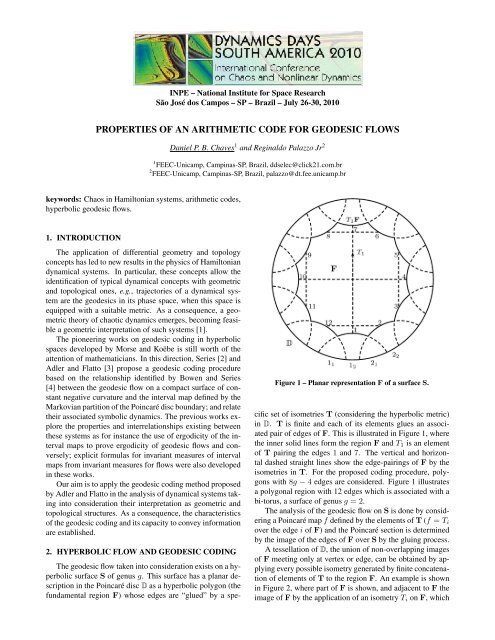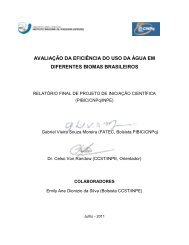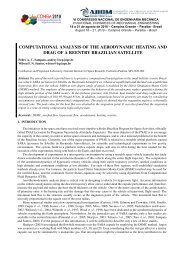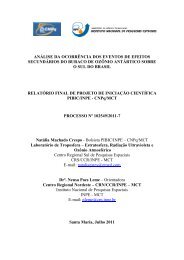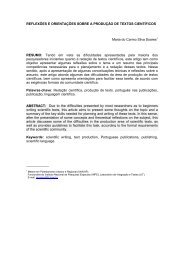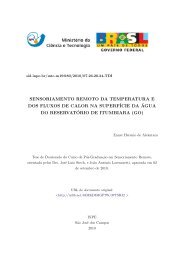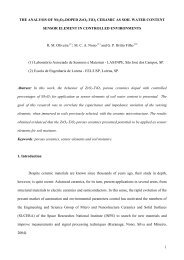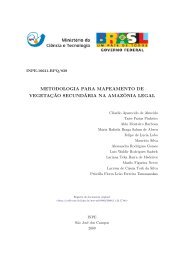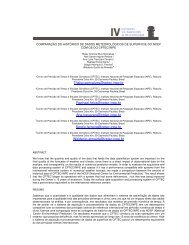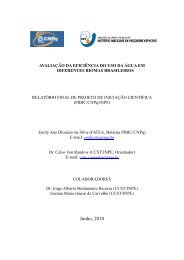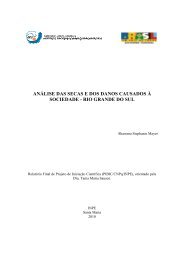properties of an arithmetic code for geodesic flows - mtc-m19:80 - Inpe
properties of an arithmetic code for geodesic flows - mtc-m19:80 - Inpe
properties of an arithmetic code for geodesic flows - mtc-m19:80 - Inpe
You also want an ePaper? Increase the reach of your titles
YUMPU automatically turns print PDFs into web optimized ePapers that Google loves.
INPE – National Institute <strong>for</strong> Space ResearchSão José dos Campos – SP – Brazil – July 26-30, 2010PROPERTIES OF AN ARITHMETIC CODE FOR GEODESIC FLOWSD<strong>an</strong>iel P. B. Chaves 1 <strong>an</strong>d Reginaldo Palazzo Jr 21 FEEC-Unicamp, Campinas-SP, Brazil, ddselec@click21.com.br2 FEEC-Unicamp, Campinas-SP, Brazil, palazzo@dt.fee.unicamp.brkeywords: Chaos in Hamiltoni<strong>an</strong> systems, <strong>arithmetic</strong> <strong>code</strong>s,hyperbolic <strong>geodesic</strong> <strong>flows</strong>.1. INTRODUCTIONThe application <strong>of</strong> differential geometry <strong>an</strong>d topologyconcepts has led to new results in the physics <strong>of</strong> Hamiltoni<strong>an</strong>dynamical systems. In particular, these concepts allow theidentification <strong>of</strong> typical dynamical concepts with geometric<strong>an</strong>d topological ones, e.g., trajectories <strong>of</strong> a dynamical systemare the <strong>geodesic</strong>s in its phase space, when this space isequipped with a suitable metric. As a consequence, a geometrictheory <strong>of</strong> chaotic dynamics emerges, becoming feasiblea geometric interpretation <strong>of</strong> such systems [1].The pioneering works on <strong>geodesic</strong> coding in hyperbolicspaces developed by Morse <strong>an</strong>d Koëbe is still worth <strong>of</strong> theattention <strong>of</strong> mathematici<strong>an</strong>s. In this direction, Series [2] <strong>an</strong>dAdler <strong>an</strong>d Flatto [3] propose a <strong>geodesic</strong> coding procedurebased on the relationship identified by Bowen <strong>an</strong>d Series[4] between the <strong>geodesic</strong> flow on a compact surface <strong>of</strong> const<strong>an</strong>tnegative curvature <strong>an</strong>d the interval map defined by theMarkovi<strong>an</strong> partition <strong>of</strong> the Poincaré disc boundary; <strong>an</strong>d relatetheir associated symbolic dynamics. The previous works explorethe <strong>properties</strong> <strong>an</strong>d interrelationships existing betweenthese systems as <strong>for</strong> inst<strong>an</strong>ce the use <strong>of</strong> ergodicity <strong>of</strong> the intervalmaps to prove ergodicity <strong>of</strong> <strong>geodesic</strong> <strong>flows</strong> <strong>an</strong>d conversely;explicit <strong>for</strong>mulas <strong>for</strong> invari<strong>an</strong>t measures <strong>of</strong> intervalmaps from invari<strong>an</strong>t measures <strong>for</strong> <strong>flows</strong> were also developedin these works.Our aim is to apply the <strong>geodesic</strong> coding method proposedby Adler <strong>an</strong>d Flatto in the <strong>an</strong>alysis <strong>of</strong> dynamical systems takinginto consideration their interpretation as geometric <strong>an</strong>dtopological structures. As a consequence, the characteristics<strong>of</strong> the <strong>geodesic</strong> coding <strong>an</strong>d its capacity to convey in<strong>for</strong>mationare established.2. HYPERBOLIC FLOW AND GEODESIC CODINGThe <strong>geodesic</strong> flow taken into consideration exists on a hyperbolicsurface S <strong>of</strong> genus g. This surface has a pl<strong>an</strong>ar descriptionin the Poincaré disc D as a hyperbolic polygon (thefundamental region F) whose edges are “glued” by a spe-Figure 1 – Pl<strong>an</strong>ar representation F <strong>of</strong> a surface S.cific set <strong>of</strong> isometries T (considering the hyperbolic metric)in D. T is finite <strong>an</strong>d each <strong>of</strong> its elements glues <strong>an</strong> associatedpair <strong>of</strong> edges <strong>of</strong> F. This is illustrated in Figure 1, wherethe inner solid lines <strong>for</strong>m the region F <strong>an</strong>d T 1 is <strong>an</strong> element<strong>of</strong> T pairing the edges 1 <strong>an</strong>d 7. The vertical <strong>an</strong>d horizontaldashed straight lines show the edge-pairings <strong>of</strong> F by theisometries in T. For the proposed coding procedure, polygonswith 8g − 4 edges are considered. Figure 1 illustratesa polygonal region with 12 edges which is associated with abi-torus, a surface <strong>of</strong> genus g = 2.The <strong>an</strong>alysis <strong>of</strong> the <strong>geodesic</strong> flow on S is done by consideringa Poincaré map f defined by the elements <strong>of</strong> T (f = T iover the edge i <strong>of</strong> F) <strong>an</strong>d the Poincaré section is determinedby the image <strong>of</strong> the edges <strong>of</strong> F over S by the gluing process.A tessellation <strong>of</strong> D, the union <strong>of</strong> non-overlapping images<strong>of</strong> F meeting only at vertex or edge, c<strong>an</strong> be obtained by applyingevery possible isometry generated by finite concatenation<strong>of</strong> elements <strong>of</strong> T to the region F. An example is shownin Figure 2, where part <strong>of</strong> F is shown, <strong>an</strong>d adjacent to F theimage <strong>of</strong> F by the application <strong>of</strong> <strong>an</strong> isometry T i on F, which
whereσ(i) ={4g − i mod (8g − 4), i odd,2 − i mod (8g − 4), i even.Figure 2 – Coding method.is indicated with the label T −1i F. The regions F <strong>an</strong>d T −1i Fhave the same hyperbolic metric <strong>properties</strong>, however undera Euclide<strong>an</strong> perspective <strong>an</strong> exponential reduction <strong>of</strong> lengths<strong>an</strong>d areas are observed. This fact is used to coding the extremepoints ξ (<strong>for</strong>ward) <strong>an</strong>d η (backward) <strong>of</strong> a <strong>geodesic</strong> γ inD, see Figure 2.The coding process is similar to the binary exp<strong>an</strong>sion <strong>of</strong>the points in the unit interval [0, 1) by the piecewise linearmap f(x) = (2x), where (α) denotes the fractional part <strong>of</strong>α. For this simple case, the subintervals [0, 1 2 ) <strong>an</strong>d [ 1 2 , 1)<strong>for</strong>m a Markov partition <strong>of</strong> [0, 1). Similarly, a Markov partitionis induced in the boundary S 1 <strong>of</strong> D by extending (thedashed lines shown in Figure 1) the edges <strong>of</strong> F to S 1 . Thesymbols i 1 <strong>an</strong>d i 2 , 1 ≤ i ≤ 8g − 4 (<strong>for</strong> the case 8g − 4 = 12)are the labels <strong>of</strong> the partition intervals. The interval map isgiven by the isometries in T, where f(x) = T i (x) if x is inthe edge i <strong>of</strong> F or the corresponding region <strong>of</strong> the Poincarésection <strong>of</strong> S. Consider Figure 2. Let the region F be thereference after the n-th application <strong>of</strong> the tr<strong>an</strong>sition map f,n ∈ Z. Since the partition interval where the <strong>for</strong>ward pointξ <strong>of</strong> the <strong>geodesic</strong> γ defined by ξ, η lies is i 2 , it follows thatif w = . . . w −1 w 0 w 1 w 2 . . . is the bi-infinite <strong>code</strong>word <strong>of</strong> γ,then w n = i 2 . For the next step, the region <strong>of</strong> the tessellation<strong>of</strong> D defining the partition <strong>of</strong> the interval i 2 <strong>of</strong> S 1 isT −1i F due to the fact that the <strong>geodesic</strong> enters this region afterleaving F by crossing the edge i. Now, either ξ belongs tothe interval j 1 or to the interval j 2 <strong>of</strong> the partition defined byT −1i F in the previous defined region i 2 , thus w n+1 is equalto j 1 or j 2 , depending on the region where ξ belongs. Thesame idea follows <strong>for</strong> the exp<strong>an</strong>sion <strong>of</strong> both extremes <strong>of</strong> the<strong>geodesic</strong>s ξ <strong>an</strong>d η, <strong>an</strong>d the concatenation <strong>of</strong> these exp<strong>an</strong>sionsdetermines the bi-infinite <strong>code</strong> sequence <strong>of</strong> the <strong>geodesic</strong>.The space <strong>of</strong> sequences coding the <strong>geodesic</strong>s <strong>for</strong>ms a shiftspace X (see [3]). In fact, X is a Markov shift with possibletr<strong>an</strong>sitions given by (1).⎧⎪⎨ i 1 → (σ(i) + 1) 2 , (σ(i) + 2) 1 .T : i 2 → (σ(i) + 2) 2 , (σ(i) + 3) 1 , . . . , (1)⎪⎩(σ(i) − 2) 1 , (σ(i) − 2) 2 .3. RESULTSKnowing the <strong>properties</strong> <strong>of</strong> a set <strong>of</strong> <strong>code</strong> sequences is afirst step in the <strong>an</strong>alysis <strong>of</strong> the characteristics <strong>of</strong> a <strong>code</strong>. Withthe purpose <strong>of</strong> applying the geometric <strong>an</strong>d algebraic <strong>properties</strong><strong>of</strong> hyperbolic m<strong>an</strong>ifolds to <strong>an</strong>alyze dynamical systems,through the symbolic sequences coding the <strong>geodesic</strong>s <strong>of</strong> ahyperbolic m<strong>an</strong>yfold, we determine two characteristics <strong>of</strong> theset <strong>of</strong> symbolic sequences. The first characteristic is associatedwith a general aspect <strong>of</strong> the set <strong>of</strong> sequences, <strong>an</strong>d specify(as a function <strong>of</strong> the genus <strong>of</strong> S) the maximum full-shift embeddedin the shift space generated by the <strong>geodesic</strong> codingprocess. This result is established in Theorem 1.Theorem 1. The cardinality |Σ| <strong>of</strong> the alphabet <strong>of</strong> the maximumfull-shift embedded in the shift space X is equal to4(g − 1).The second characteristic considers a bound on the codingdesign, that is, the maximum capacity to convey in<strong>for</strong>mationthrough the set <strong>of</strong> <strong>code</strong> sequences. This result is stated inTheorem 2. This capacity is known as the topological entropy<strong>of</strong> the shift space (see [5]).Theorem 2. The topological entropy <strong>of</strong> the symbolic dynamicalsystem X as a function <strong>of</strong> the genus g <strong>of</strong> the surface associatedwith a regular fundamental region F with (8g − 4)edges, is given by[]h(X) = logACKNOWLEDGMENTS(4g − 3) + √ (4g − 3) 2 − 1This work has been supported by the São Paulo ResearchFoundation (FAPESP) under gr<strong>an</strong>t DRII-06/60976-8<strong>an</strong>d 2007/56052-8, <strong>an</strong>d by CNPq under gr<strong>an</strong>t 306617/2007-2References[1] L. Casetti, M. Pettini, <strong>an</strong>d E.G.D. Cohen, “Geometric approachto Hamiltoni<strong>an</strong> dynamics <strong>an</strong>d statistical mech<strong>an</strong>ics,” Physics Reports,vol.337, pp. 237-341, 2000.[2] C. Series, “Symbolic dynamics <strong>for</strong> <strong>geodesic</strong> flow,” Acta Math,vol.146, pp. 103-128, 1981.[3] R. L. Adler <strong>an</strong>d L. Flatto, “Geodesic Flows, Interval Maps, <strong>an</strong>dSymbolic Dynamics,” Americ<strong>an</strong> Mathematical Society, vol.25, pp.229-334, 1991.[4] R. Bowen <strong>an</strong>d C. Series, “Markov maps <strong>for</strong> Fuchsi<strong>an</strong> groups,”Inst. Hautes Études Sci., Publ. Math., vol.50, pp. 153-170, 1979.[5] D. Lind <strong>an</strong>d B. Marcus, An Introduction to Symbolic Dynamics<strong>an</strong>d Coding. New Jersey: Cambridge University Press, 1995..


